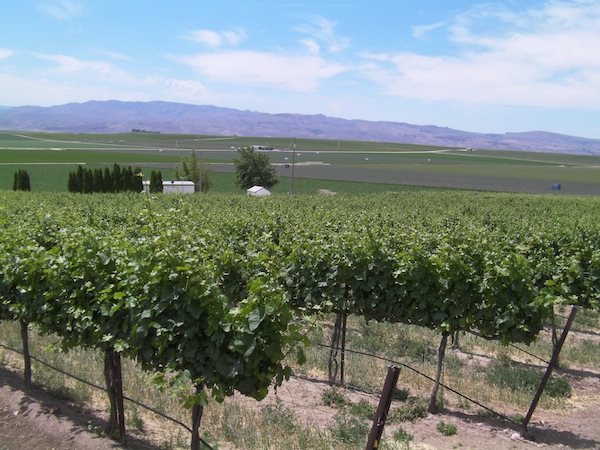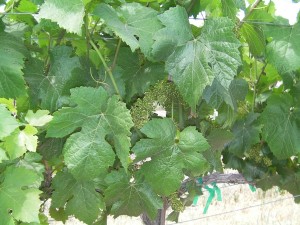
Note: This is the second in a four-part series on Northwest Pinot Gris.
CALDWELL, Idaho – Riesling and white Rhône varieties thrive in the high-elevation, long-season viticulture of Idaho’s Snake River Valley, but two of the state’s largest wineries have proven Pinot Gris can succeed at 2,800 feet.
And this spring, 3 Horse Ranch Vineyards in the Eagle Foothills north of Boise won a gold medal at the Northwest Wine Summit for its 2012 Estate Pinot Gris.
“I think it would be interesting to see Pinot Gris planted in some more sites to see how it would do because the few versions that I’ve seen from Idaho are actually quite good, but it certainly doesn’t get as much attention as Riesling and Chardonnay and Viognier,” said Greg Koenig, who makes the wine for 3 Horse Ranch owner Gary Cunningham. “Pinot Gris is way down the list in terms of acres planted. I think it would be a great grape for this region, even though it’s a long growing region.”

Champions for the Burgundy variety include Kathryn House, former assistant winemaker at Betz Family Winery in Woodinville, Wash., and now a winemaking and viticulture consultant in Boise.
“I do see a strong basis for Pinot Gris because of the natural acidity the grape does retain to provide balance and the weight,” said House, who operates Wine Wise Idaho. “It’s a wine that has a rap for not being a drinking man’s wine, but I’m seeing more minerality in some of the wines. We’re so young that we’re still trying to find out what’s right for us, but it’s a fascinating grape to work with.”
No one makes more Pinot Gris in Idaho than Koenig. For the past five vintages, he has brought those grapes into his Koenig Vineyards production facility on Caldwell’s Sunnyslope, starting in 2008. The smallest vintage was 440 cases. He produced more than 800 cases from 2012.
“It’s sun-drenched viticulture here,” Koenig said. “We have an amazing amount of sunny days here, and that can adversely affect grapes like Pinot Gris. You have a dark-skinned grape anyway, and you are trying to make a delicate wine out of it. If the skins are too developed or too sunburned, they tend to impart flavors that are a little more tropical and a little more richer – away from the cool, crisp, acidic wines that people expect from Pinot Gris.”

Meredith Smith, associate winemaker at Precept-owned Sawtooth, produced 720 cases of 2012 Pinot Gris from the estate Clone 1 vines on the rise just below the winery and tasting room south of Nampa. She targets 22.5 to 23 brix for those 3.8 acres of Pinot Gris.
“The Pinot Gris that we make at Sawtooth we have about 0.5 percent residual sugar on it, so it’s a little bit drier style,” Smith said. “We like the acidity high, and we like the fruit very vibrant. And it’s all tank fermented. Sometimes, we’ll add a bit of Muscat Blanc, but for the 2012 vintage, we didn’t add very much Muscat Blanc at all.”
At 3 Horse Ranch, Koenig said he has no trouble reaching that similar brix level, but he’s looking for some changes. In recent vintages, Cunningham has delivered Pinot Gris at 2 to 2.5 tons per acre. Koenig sounds more like a farmer than a winemaker when he talks of wanting see a heavier crop load of 4 tons per acre.
“The sugars at 3 Horse Ranch are very interesting,” he said. “Even though the grapes get phenolically ripe — sometimes a little overripe because of the intense sunlight — the sugar levels are 22 to 23 brix, which is wonderful. Flavorwise, I think we could have a little more canopy and still achieve 22-23 brix and little bit more acid, so our goal for the next 2-3 years out there is to add a little more water and possibly a little fertilizer because the soils out there are so poor. The soils are very, very sandy with a little bit of ash and decomposed granite, so it’s super-well drained. I don’t think you could overwater that vineyard if you watered every day.”

Koenig also appreciates the Pinot Gris created at Sawtooth, which also has an elevation of about 2,700 feet but carries some different characteristics.
“Sawtooth has a lot better soil profile for water capacity and for white wines like Viognier, Roussanne, Pinot Gris,” Koenig said. “The Pinot Gris is wonderful and citrusy – a really nice white. I’m not sure how Pinot Gris would do on the Sunnyslope. We’d probably be somewhere in between because our water capacity is less in the soils than Sawtooth but certainly not as dry as 3 Horse Ranch.”
David Minick, vice president of vineyards at Precept and founding winemaker at Willow Crest Winery in Prosser, Wash., said the only Idaho Pinot Gris he’s tasted is from Sawtooth, but he likes what he sees.
“The Pinot Gris that I’ve made at Willow Crest has more Granny Smith and ripe pear,” Minick said. “The Sawtooth has got more tropical notes to it than mine.”
There is no Pinot Gris planted at Skyline, the much larger sister vineyard for Sawtooth, which also is managed by Winemakers LLC for Dan Baty, who owns Precept with Andrew Browne.
“The Pinot Gris there is very nice, very true to the variety, and Sawtooth is successful in selling it,” Minick said. “We’ve talked about planting more (in Idaho), we just haven’t done it yet.”
And there’s room to grow at 3 Horse Ranch, too, which has been certified USDA organic.
“There are no crops next to them so there are no pests, so they are able to farm in this isolated place and farm organically, which is hard to do if you have neighbors or crops nearby,” Koenig said. “And there’s no moisture from nearby crops that would cause mildew pressures. They have so little chemical input in the vineyard, which is great. It’s a unique situation, and it’s great to work with grapes like that. They are grown on their own rootstocks, and there’s virtually no chemical input so it’s true, pure fruit.”
Cunningham skillfully uses his vineyard’s history to sell his wines, but both 3 Horse Ranch and Sawtooth achieve success in the market with Pinot Gris because the variety now has the ability to sell itself.
“Consumers know what it is, whether it’s labeled Pinot Grigio or Pinot Gris. That’s important when you are trying to make a wine people actually know what it is,” Koenig said. “People are willing to experiment, but if you are trying to sell a significant amount – 800 cases – you have to have something that people have heard of because you can’t sell it all out of your tasting room. You have to have it on retail shelves and have the consumers have an idea.”
“And consumers certainly love it,” Koenig said, adding he’d enjoy experimenting with the variety in other areas of the Snake River Valley.
“It would be nice to see some cool-climate versions with heavy soils like over by Kuna at Indian Creek (Winery), where they are successful with Pinot Noir,” Koenig said. “I think it would create more crisp, Alsatian flavors. And then there are the versions in 3 Horse Ranch and Sawtooth that are doing well. I’d love to see more and love to have the chance to work with some at Koenig. I might convince a grower to put some in.”

Leave a Reply